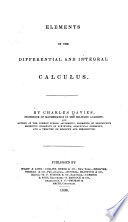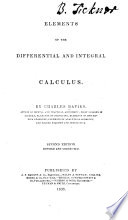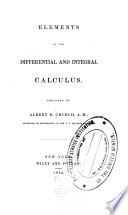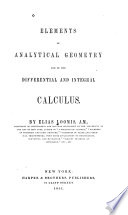 | Charles Davies - Calculus - 1836 - 296 pages
...result, u'v' — uv ~h or passing to the limit, d(uv) therefore, d(uv) = vPdx + uQdx = vdu + udv. Hence, the differential of the product of two functions dependent on the same variable, is equal to the sum of the products which arise by multiplying each by the differential of the other. 29. If the differential... | |
 | Charles Davies - Calculus - 1838 - 300 pages
...result, u'v' — uv or passing to the limit, d(uv) therefore, d(uv) — vPdx + uQdx = vdu + udv. Hence, the differential of the product of two functions dependent on the same variable, is equal to the sum of the products which arise by multiplying each by the differential of the other. 29. If the differential... | |
 | Albert Ensign Church - Calculus - 1842 - 340 pages
...functions, we may in the same way prove, that the differential of the product of any number of functions of the same variable, is equal to the sum of the products obtained by multiplying the differential of each into all the others. 21. If we divide both members of equation... | |
 | Elias Loomis - Calculus - 1851 - 296 pages
...is the differential of 5x'-3x'+6x+2'>. Ans. Ex. 6. What is the differential of rJx'+6x'-5ax'+3x-6l Ans. PROPOSITION IX. — THEOREM. (180.) The differential...designate two functions by u and v, and suppose them to dependgon the same variable x ; then, when x is increased so as to become x+h, the new functions may... | |
 | Elias Loomis - Calculus - 1851 - 300 pages
...Ans. PROPOSITION X. — THEOREM. (182.) The differential of the product of any number of functions of the same variable, is equal to the sum of the products obtained by multiplying the differential of each function by the product of the others. Let us designate three... | |
 | Elias Loomis - Calculus - 1856 - 300 pages
...(,' .Ex. 6. What is the differential of 7z'+6a;'-5aa;'+3a;-6f Ans. ( /j~y .'-. ; : fy '-/pa ;/ W^* ' PROPOSITION IX. — THEOREM. (180.) The differential...become x+h, the new functions may be written, Art. 178, u'=u+Ah +BA', u'=u+A'A+B'A3. If we multiply together the corresponding members of these equations,... | |
 | Albert Ensign Church - Calculus - 1870 - 394 pages
...we may in the same way prove, that the differential of the product of any number of functions of Ihe same variable, is equal to the sum of the products obtained by multiplying the differential of each into all the others. Thus, if uv = ax', bx, d(uv) = ax'.d(bx)... | |
 | Joseph Ficklin - Algebra - 1874 - 446 pages
...derived functions. GO4. The first derivative of the product of two functions of the same quantity is equal to the sum of the products obtained by multiplying each by the first derivative of the ether. Substituting x + h for x in tho two expressions f(x) and f1(x), we obtain... | |
 | William Kent - Engineering - 1895 - 1234 pages
...differentials taken separately : If и — y -\- z — to, du = dy 4- dz — dw. The differential of a product, of two functions dependent on the same, variable is equal to the sum of the products of each by the differential of the other: , d(>iv) ilu , <lv d(uv) = vdu + udv. — - = —... | |
 | William Kent - Engineering - 1902 - 1204 pages
...their differentials taken separately: If u = y + z — w, du = dy -)- dz — dw. The differential of a product of two functions dependent on the same variable is equal to the sum of the products of each by the differential of the other : . . . d(nv) du , dv dC«i>) = vdu + udv. — -... | |
| |